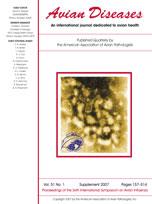A study was conducted to evaluate efficacy of inactivated, reverse genetics-based H5N3 avian influenza vaccines and the predictive ability of a vaccination/serology model for testing vaccine batches. Serologic response, protection against mortality, and protection against viral shedding from trachea and cloaca were assessed for vaccines prepared varying only in antigen content. When the birds were grouped according to serologic response, a clear association with protection could be seen. In general, for birds possessing a nonmeasurable titer (<10), mortality after challenge was a near certainty. Low titers of 10 to 40 resulted in the prevention of mortality but not viral shedding. Titers greater than 40 prevented mortality and reduced viral shedding. The results suggest that a test model including vaccination of chickens at 3 wk, bleeding at 6 wk, and quantitative assessment of serologic response by using a standardized hemagglutination inhibition assay system can be an excellent predictor of vaccine efficacy.
How to translate text using browser tools
1 March 2007
Association of Serologic and Protective Responses of Avian Influenza Vaccines in Chickens
Mahesh Kumar,
Hsien-Jue Chu,
Jeff Rodenberg,
Scott Krauss,
Robert G. Webster
ACCESS THE FULL ARTICLE

Avian Diseases
Vol. 51 • No. s1
March 2007
Vol. 51 • No. s1
March 2007
avian influenza
H5N1, WHO = World Health Organization
reverse genetics
vaccines




